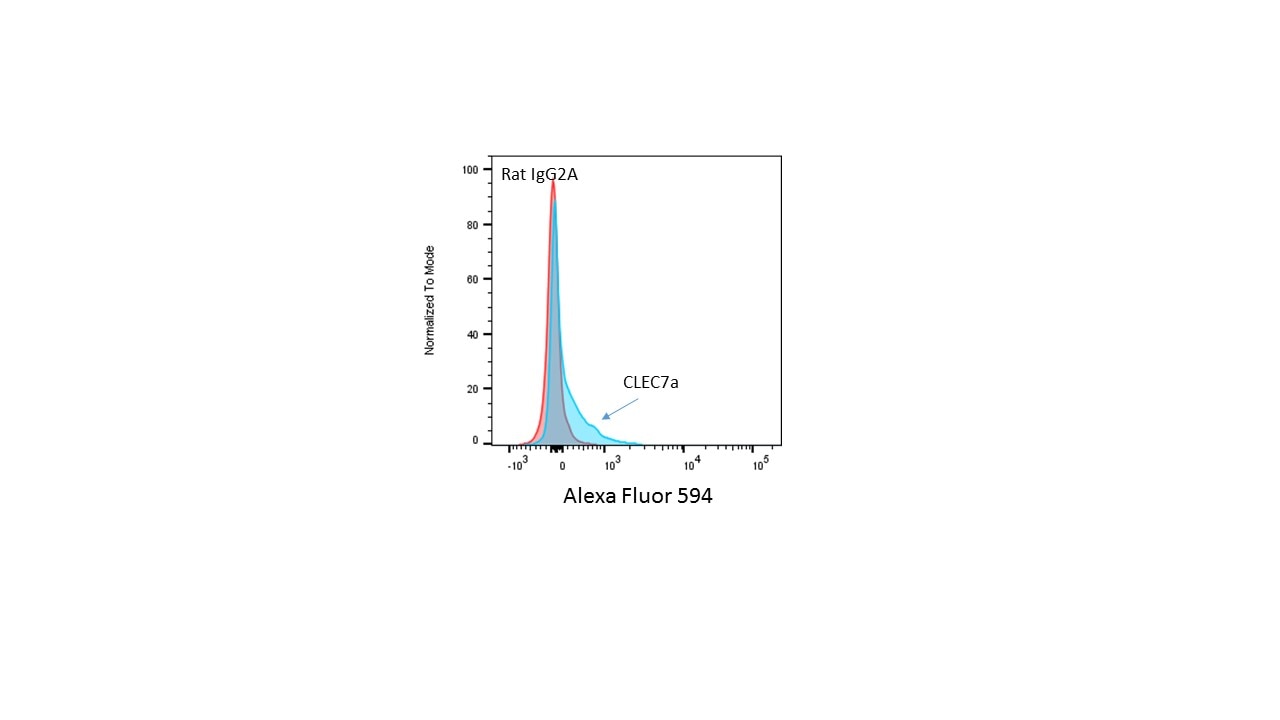Mouse Dectin-1/CLEC7A Alexa Fluor® 594-conjugated Antibody Summary
Phe69-Leu244
Accession # Q6QLQ4
Applications
Please Note: Optimal dilutions should be determined by each laboratory for each application. General Protocols are available in the Technical Information section on our website.
Scientific Data
 View Larger
View Larger
Detection of Dectin‑1/CLEC7A in HEK293 Human Cell Line transfected with Mouse Dectin-1/CLEC7A by Flow Cytometry. HEK293 cell line transfected with Mouse Dectin-1/CLEC7A (filled histogram) or irrelevant protein (open histogram) was stained with Rat Anti-Mouse Dectin‑1/CLEC7A Alexa Fluor® 594‑conjugated Monoclonal Antibody (Catalog # FAB17561T). Staining was performed using our Staining Membrane-associated Proteins protocol.
 View Larger
View Larger
Detection of Dectin‑1/CLEC7A in Raw264.7 Mouse Cell Line by Flow Cytometry. Mouse Raw264.7 monocyte/macrophage cell line was stained with Rat Anti-Mouse Dectin-1/CLEC7A Alexa Fluor® 594-conjugated Monoclonal Antibody (Catalog # FAB17561T, filled histogram) or Rat IgG2A Isotype Control (IC006T, open histogram). Staining was performed using our Staining Membrane-associated Proteins protocol.
Reconstitution Calculator
Preparation and Storage
- 12 months from date of receipt, 2 to 8 °C as supplied.
Background: Dectin-1/CLEC7A
Dectin-1, also known as CLEC7A and the beta -glucan receptor, is a 43 kDa type II transmembrane C-type lectin that functions in the innate immune response to fungal pathogens. Although Dectin-1 resembles other CLEC molecules structurally, it binds ligands in a calcium-independent manner (1, 2). Mature mouse Dectin-1 is a 244 amino acid (aa) glycoprotein that consists of a short ITAM-containing cytoplasmic tail, a transmembrane segment, and a stalk and carbohydrate recognition domain (CRD) in the extracellular domain (3). The CRD of mouse Dectin-1 shares 61%, 60%, and 87% aa sequence identity with that of bovine, human, and rat Dectin‑1, respectively. It shares 25%‑34% aa sequence identity with the CRD of other subgroup members CLEC-1, CLEC-2, CLEC9A, CLEC12B, LOX-1, and MICL. Mouse Dectin-1 is alternately spliced, generating a variant that lacks the stalk region (4). Mouse Dectin-1 is expressed on monocytes, macrophages, and neutrophils, and on some populations of dendritic cells and T cells (5). It is upregulated on macrophages by GM-CSF, IL-4, or IL-13 and downregulated by dexamethasone, IL-10, or LPS (6). The CRD selectively binds beta -glucan polymers, a major component of yeast and mycobacterial cell walls (7). Yeast beta -glucan is accessible to Dectin-1 only at sites of cell budding, and Dectin-1 does not recognize the filamentous form of yeast (8). Dectin-1 mediates the phagocytosis of zymosan particles and intact yeast (8‑10). It co-localizes with TLR2 in the presence of zymosan, and the two receptors cooperate in ligand recognition and the propagation of proinflammatory signaling (9, 11‑13). Dectin-1 interaction with the tetraspanin CD37 increases its stability on the cell membrane and inhibits ligand-induced signaling (14). Genetic knockout of Dectin-1 in mice increases their susceptibility to pathogenic infection (15, 16).
- Kanazawa, N. (2007) J. Dermatol. Sci. 45:77.
- Brown, G.D. (2006) Nat. Rev. Immunol. 6:33.
- Ariizumi, K. et al. (2000) J. Biol. Chem. 275:20157.
- Heinsbroek, S.E.M. et al. (2006) J. Immunol. 176:5513.
- Taylor, P.R. et al. (2002) J. Immunol. 169:3876.
- Willment, J.A. et al. (2003) J. Immunol. 171:4569.
- Palma, A.S. et al. (2006) J. Biol. Chem. 281:5771.
- Gantner, B.N. et al. (2005) EMBO J. 24:1277.
- Gantner, B.N. et al. (2003) J. Exp. Med. 197:1107.
- Kennedy, A.D. et al. (2007) Eur. J. Immunol. 37:467.
- Brown, G.D. et al. (2003) J. Exp. Med. 197:1119.
- Yadav, M. and J.S. Schorey (2006) Blood 108:3168.
- Suram, S. et al. (2006) J. Biol. Chem. 281:5506.
- Meyer-Wentrup, F. et al. (2007) J. Immunol. 178:154.
- Saijo, S. et al. (2007) Nat. Immunol. 8:39.
- Taylor, P.R. et al. (2007) Nat. Immunol. 8:31.
Product Datasheets
Product Specific Notices
This product is provided under an agreement between Life Technologies Corporation and R&D Systems, Inc, and the manufacture, use, sale or import of this product is subject to one or more US patents and corresponding non-US equivalents, owned by Life Technologies Corporation and its affiliates. The purchase of this product conveys to the buyer the non-transferable right to use the purchased amount of the product and components of the product only in research conducted by the buyer (whether the buyer is an academic or for-profit entity). The sale of this product is expressly conditioned on the buyer not using the product or its components (1) in manufacturing; (2) to provide a service, information, or data to an unaffiliated third party for payment; (3) for therapeutic, diagnostic or prophylactic purposes; (4) to resell, sell, or otherwise transfer this product or its components to any third party, or for any other commercial purpose. Life Technologies Corporation will not assert a claim against the buyer of the infringement of the above patents based on the manufacture, use or sale of a commercial product developed in research by the buyer in which this product or its components was employed, provided that neither this product nor any of its components was used in the manufacture of such product. For information on purchasing a license to this product for purposes other than research, contact Life Technologies Corporation, Cell Analysis Business Unit, Business Development, 29851 Willow Creek Road, Eugene, OR 97402, Tel: (541) 465-8300. Fax: (541) 335-0354.
FAQs
No product specific FAQs exist for this product, however you may
View all Antibody FAQsReviews for Mouse Dectin-1/CLEC7A Alexa Fluor® 594-conjugated Antibody
Average Rating: 4 (Based on 1 Review)
Have you used Mouse Dectin-1/CLEC7A Alexa Fluor® 594-conjugated Antibody?
Submit a review and receive an Amazon gift card.
$25/€18/£15/$25CAN/¥75 Yuan/¥2500 Yen for a review with an image
$10/€7/£6/$10 CAD/¥70 Yuan/¥1110 Yen for a review without an image
Filter by:



